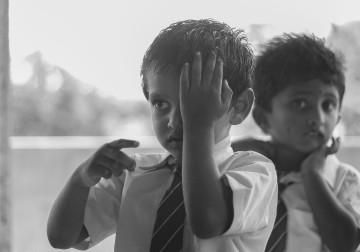In a new study, Drs. Rohit Dhakal, Pavan K. Verkicharla, and others from LVPEI and City University, London assessed light exposure patterns among Indian schoolchildren with myopia. The study explores the role of sufficient sunlight exposure in preventing myopia and controlling its progression.
Myopia, or near-sightedness, can impair a child’s life, and education. Severe myopia could precipitate other conditions like retinal detachments, which if untreated, could lead to vision loss and blindness. Myopia is the leading cause of refractive errors among urban Indian schoolchildren and is expected to gain a prevalence of 48% by 2050. Understanding the factors that cause myopia is key to preventing this pandemic. Studies show that adequate exposure to sunlight in early childhood can play a key role in preventing or delaying myopia onset in children. A healthy exposure to sunlight can promote the release of neurotransmitters like dopamine, which regulate eye growth in children. However, most studies on the protective effects of sunlight are based on patient-reported data which are subjective and prone to error.
Wearable light trackers, small electronic devices that can record light exposure, allow for objective data gathering. Some studies have used such devices to compare outdoor light exposure between children with myopia and those without. But such studies have been performed in Western countries or on East Asian children. Racial, geographical, and cultural differences are associated with heterogeneous distribution in the prevalence of myopia. So, the findings from studies in Australia and Singapore may not translate to Indians. Globally, reduced sunlight exposure has been associated with juvenile myopia. But does that hold true for Indian children?
In a new study published in the journal BMJ Open Ophthalmology, Drs. Pavan K. Verkicharla, Rohit Dhakal, and others from LVPEI and City University, London have assessed and compared light exposure patterns among Indian schoolchildren with and without myopia. The study tracked sunlight exposure in 143 schoolchildren (50 myopes, or those with myopia), aged 9-15 years. Light exposure was recorded using the MyLyt light tracker (developed at LVPEI) for six consecutive days. Most data were obtained during school days (7:30 AM – 6:00 PM). Light exposure during non-school days was obtained from a subset of 87 children (26 myopes). Light exposure was classified to four ranges of illumination intensity (lux). The cutoff for outdoor light was 1000 lux or more, while anything below was considered indoor light. The team assessed the intensity of illumination, time spent outdoors, and frequency of exposure to one of the four illumination range categories (epoch).
On school days, there was no significant difference in median daily illumination exposure (lux/day), time spent exposed to outdoor light, and epochs between myopes and non-myopes. Most outdoor light exposure on school days was received during recess and travel to-and-from school (transition time). While the overall exposure was similar, interestingly non-myopes received higher light exposure (910 lux/day) vs. myopes (510 lux/day), spent more time outdoors (25 vs. 14 minutes/day), and had higher outdoor epochs (6 vs. 5 times/day) during transition time. On non-school days, the daily illumination exposure was significantly higher in non-myopes (6,369 lux/day) than myopes (5,623 lux/day). In fact, myopes spent only 5.13 hours/week outdoors. The study highlights the behavioral pattern related to the light exposure profile of Indian schoolchildren and the need for increased outdoor activity to safeguard their vision against myopia.
‘The findings are interesting and direct us to investigate more about the role of intermittent bright light exposure on myopia development and/or progression,’ remarks Dr. Pavan Kumar Verkicharla, Head of The Myopia Centre at LVPEI and the corresponding author of this paper. ‘Even short periods of bright light exposure might act like 'stop signal'; for unwarranted eye growth.’
Citation
Dhakal, R., Lawrenson, J. G., Huntjens, B., Shah, R., & Verkicharla, P. K. (2024). Light exposure profiles differ between myopes and non-myopes outside school hours. BMJ Open Ophthalmology, 9(1), e001469. https://doi.org/10.1136/bmjophth-2023-001469
Photo credit: Srinivas Marmamula.



